Prince Arthur, Duke of Connaught and Strathearn
Last updated| Prince Arthur | |||||
|---|---|---|---|---|---|
| Duke of Connaught and Strathearn | |||||
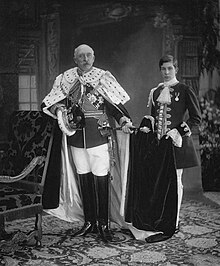 | |||||
| 10th Governor General of Canada | |||||
| In office 13 October 1911 –11 November 1916 | |||||
| Monarch | George V | ||||
| Prime Minister | |||||
| Preceded by | The Earl Grey | ||||
| Succeeded by | The Duke of Devonshire | ||||
| Born | 1 May 1850 Buckingham Palace, London, England | ||||
| Died | 16 January 1942 (aged 91) Bagshot Park, Surrey, England | ||||
| Burial | 23 January 1942 | ||||
| Spouse | |||||
| Issue | |||||
| |||||
| House | Saxe-Coburg and Gotha (until 1917) Windsor (from 1917) | ||||
| Father | Prince Albert of Saxe-Coburg and Gotha | ||||
| Mother | Queen Victoria | ||||
| Signature | | ||||
| Education | Royal Military Academy, Woolwich | ||||
| Military career | |||||
| Service/ | British Army | ||||
| Years of service | 1868–1942 | ||||
| Rank | Field Marshal | ||||
| Unit | Royal Engineers Royal Regiment of Artillery Rifle Brigade | ||||
| Commands held | Inspector-General of the Forces Commander-in-Chief,Ireland Third Army Corps Aldershot Command Southern Command Bombay Army | ||||
| Battles/wars | Fenian Raids Anglo-Egyptian War | ||||
| Awards | Volunteer Officers' Decoration Territorial Decoration | ||||
Prince Arthur,Duke of Connaught and Strathearn (Arthur William Patrick Albert;1 May 1850 –16 January 1942) was the seventh child and third son of Queen Victoria of the United Kingdom and Prince Albert of Saxe-Coburg and Gotha. He served as Governor General of Canada,the tenth since Canadian Confederation and the only British prince to do so.
Contents
- Early life
- Military career
- Peerage,marriage,and family
- Royal duties
- Governor General of Canada
- Later life
- Death
- Titles,styles,honours and arms
- Arms
- Issue
- Ancestry
- See also
- Notes
- References
- External links
Arthur was educated by private tutors before entering the Royal Military Academy at Woolwich at 16 years old. Upon graduation,he was commissioned as a lieutenant in the British Army,where he served for some 40 years,seeing service in various parts of the British Empire. During this time,he was also created a royal duke,becoming Duke of Connaught and Strathearn as well as Earl of Sussex. In 1900,he was appointed as Commander-in-Chief,Ireland,which he regretted;his preference was to join the campaign against the Boers in South Africa. [1] In 1911,he was appointed as Governor General of Canada,replacing Albert Grey,4th Earl Grey,as viceroy. He occupied this post until he was succeeded by Victor Cavendish,9th Duke of Devonshire,in 1916. He acted as the King's,and thus the Canadian Commander-in-Chief's,representative through the first years of the First World War.
After the end of his viceregal tenure,Arthur returned to the United Kingdom and performed various royal duties there and in Ireland,while also again taking up military duties. Though he retired from public life in 1928,he continued to make his presence known in the army well into the Second World War,before his death in 1942. He was Queen Victoria's last surviving son.
Early life

Arthur was born at Buckingham Palace on 1 May 1850,the seventh child and third son of Queen Victoria and Prince Albert of Saxe-Coburg and Gotha. The prince was baptised by the Archbishop of Canterbury,John Bird Sumner,on 22 June in the palace's private chapel. His godparents were Prince William of Prussia (the later King of Prussia and German Emperor Wilhelm I);his great-uncle's sister-in-law,Princess Bernard of Saxe-Weimar-Eisenach (for whom his maternal grandmother the Duchess of Kent stood proxy);and the Duke of Wellington,with whom he shared his birthday and after whom he was named. [2] [3] As with his older brothers,Arthur received his early education from private tutors. It was reported that he became the Queen's favourite child. [4]
Military career

It was at an early age that Arthur developed an interest in the army,and in 1866 he followed through on his military ambitions by enrolling at the Royal Military Academy,Woolwich,from where he graduated two years later and was commissioned as a lieutenant in the Corps of Royal Engineers on 18 June 1868. [5] The Prince transferred to the Royal Regiment of Artillery on 2 November 1868 and, [6] on 2 August 1869,to the Rifle Brigade, [7] his father's own regiment,after which he pursued a long and distinguished career as an army officer,including service in South Africa,Canada in 1869,Ireland,Egypt in 1882,and in India from 1886 to 1890.
In Canada,Arthur,as an officer with the Montreal detachment of the Rifle Brigade, [3] undertook a year's training and engaged in defending the Dominion from the Fenian Raids;there was initially concern that his personal involvement in Canada's defence might put the Prince in danger from Fenians and their supporters in the United States,but it was decided his military duty came first. [3] Following his arrival at Halifax,Arthur toured the country for eight weeks and made a visit in January 1870 to Washington,D.C.,where he met with President Ulysses S. Grant. [3] [8] During his service in Canada he was also entertained by Canadian society;among other activities,he attended an investiture ceremony in Montreal,was a guest at balls and garden parties,and attended the opening of parliament in Ottawa (becoming the first member of the royal family to do so), [8] all of which was documented in photographs that were sent back for the Queen to view. However,Arthur was not just engaged in social and state functions;on 25 May 1870 he was engaged in fending off Fenian invaders during the Battle of Eccles Hill,for which he received the Fenian Medal. [9]

Arthur made an impression on many in Canada. He was given on 1 October 1869 the title Chief of the Six Nations by the Iroquois of the Grand River Reserve in Ontario and the name Kavakoudge (meaning the sun flying from east to west under the guidance of the Great Spirit),enabling him to sit in the tribe's councils and vote on matters of tribe governance. As he became the 51st chief on the council,his appointment broke the centuries-old tradition that there should only be 50 chiefs of the Six Nations. [10] Of the Prince,Lady Lisgar,wife of then Governor General of Canada Lord Lisgar,noted in a letter to Victoria that Canadians seemed hopeful Prince Arthur would one day return as governor general. [11]
Arthur was promoted to the honorary rank of colonel on 14 June 1871, [12] substantive lieutenant-colonel in 1876, [3] colonel on 29 May 1880 and, [13] on 1 April 13 years later,was made a general. [3] He gained military experience as Commander-in-Chief of the Bombay Army from December 1886 to March 1890. [14] He went on to be General officer commanding Southern District,at Portsmouth,from September 1890 [15] [16] to 1893. [17] The Prince had hoped to succeed his first cousin once-removed,the elderly Prince George,Duke of Cambridge,as Commander-in-chief of the Forces,upon the latter's forced retirement in 1895. But this desire was denied to Arthur,and instead he was given,between 1893 [18] and 1898,command of the Aldershot District Command. [15] He was appointed Colonel-in-Chief of the Rifle Brigade in 1880 and of the 6th (Inniskilling) Dragoons in 1897,and Honorary Colonel of the 3rd (West Kent Militia) Battalion,Queen's Own (Royal West Kent Regiment) in 1884. [19] In August 1899 the 6th Battalion,Rifles of the Canadian Non-Permanent Active Militia,located in Vancouver,British Columbia,asked Prince Arthur to give his name to the regiment and act as its honorary colonel. The regiment had recently been converted to the infantry role from the 2nd Battalion,5th British Columbia Regiment of Canadian Artillery. With the Prince's agreement the unit was renamed 6th Regiment,Duke of Connaught's Own Rifles (DCORs) on 1 May 1900. He was subsequently appointed colonel-in-chief of the regiment,then known as The British Columbia Regiment (Duke of Connaught's Own),in 1923. He held that appointment until his death. Additionally,in 1890 he became patron of,giving his name to,the 6th Duke of Connaught's Royal Canadian Hussars,which in 1958 amalgamated with 17th Duke of York's Royal Canadian Hussars,to become the Royal Canadian Hussars.
On 26 June 1902 he was promoted to the post of field marshal,and thereafter served in various important positions,including Commander-in-Chief,Ireland,from January 1900 [20] to 1904,with the dual position of commander of the Third Army Corps from October 1901, [21] and Inspector-General of the Forces,between 1904 and 1907.
For a brief period of time,after the May Coup that took place in Serbia in 1903,he was among those considered for the vacant Serbian throne after the extinction of the then ruling Obrenovićdynasty. His succession was advocated particularly among the conservative anglophile circles,represented most prominently by Čedomilj Mijatović,then Serbian ambassador to the Court of St James's. [22]
Peerage,marriage,and family
On his mother's birthday (24 May) in 1874,Arthur was created a royal peer,being titled as the Duke of Connaught and Strathearn and Earl of Sussex. [23] Some years later,Arthur came into the direct line of succession to the Duchy of Saxe-Coburg and Gotha in Germany,upon the death in 1899 of his nephew,Prince Alfred of Edinburgh,the only son of his elder brother,Prince Alfred,Duke of Edinburgh. He decided,however,to renounce his own and his son's succession rights to the duchy,which then passed to his other nephew,Prince Charles Edward,the posthumous son of Prince Leopold,Duke of Albany. [24]

At St. George's Chapel,Windsor Castle,on 13 March 1879,Arthur married Princess Louise Margaret of Prussia,the daughter of Prince Frederick Charles and a great-niece of the German Emperor,Arthur's godfather,Wilhelm I. The couple had three children:Princess Margaret Victoria Charlotte Augusta Norah (born 15 January 1882 –1 May 1920),Prince Arthur Frederick Patrick Albert (born 13 January 1883 –12 September 1938),and Princess Victoria Patricia Helena Elizabeth (born 17 March 1886 –12 January 1974),who were all raised at the Connaughts' country home,Bagshot Park,in Surrey,and after 1900 at Clarence House,the Connaughts' London residence. Through his children's marriages,Arthur became the father-in-law of Crown Prince Gustaf Adolf of Sweden;Princess Alexandra,Duchess of Fife;and Sir Alexander Ramsay. Arthur's first two children predeceased him;Margaret while pregnant with his sixth grandchild. [n 1] For many years,Arthur maintained a liaison with Leonie,Lady Leslie,sister of Jennie Churchill,while still remaining devoted to his wife. [25]
Royal duties

Alongside his military career,the Duke continued to undertake royal duties beyond,or only vaguely associated with,the army. He also represented the monarchy throughout the Empire. On the return from a posting in India,he again,this time with his wife,toured Canada in 1890,stopping in all major cities across the country. [10] He also toured Canada in 1906. [26] In January 1903,the Duke and Duchess represented the new King Edward VII at the 1903 Delhi Durbar to celebrate his accession. On their way to India,the couple passed through Egypt where the Duke opened the Aswan dam on 10 December 1902. [27]
In 1910,Arthur travelled aboard the Union-Castle Line ship Balmoral Castle to South Africa,to open the first parliament of the newly formed Union of South Africa, [28] and in Johannesburg on 30 November he laid a commemorative stone at the Rand Regiments Memorial,dedicated to the British soldiers that died during the Second Boer War. [29]
Prince Arthur was a Freemason and was elected as Grand Master of the United Grand Lodge of England when his elder brother was obliged to resign the office upon his accession in 1901 as King Edward VII. He was subsequently re-elected an additional 37 times before 1939,when the Prince was nearly 90 years of age.
Governor General of Canada
It was announced on 6 March 1911 that King George V had,by commission under the royal sign-manual,approved the recommendation of his British prime minister,H.H. Asquith,to appoint Arthur as Governor General of Canada,the representative of the monarch. [30] His brother-in-law,John Campbell,9th Duke of Argyll,had previously served as the country's governor general,but when Arthur was sworn in on 13 October 1911 in the salon rouge of the parliament buildings of Quebec, [31] he became the first Governor General who was a member of the British royal family. [30]

To Canada,Arthur brought with him his wife and his youngest daughter,the latter of whom would become an extremely popular figure with Canadians. The Governor General and his viceregal family travelled throughout the country,performing such constitutional and ceremonial tasks as opening parliament in 1911 (for which Arthur wore his field marshal's uniform and the Duchess of Connaught wore the gown she had worn at the King's coronation earlier that year) and, [31] in 1917,laying at the newly rebuilt Centre Block on Parliament Hill the same cornerstone his older brother,the late King Edward VII,had set on 1 September 1860,when the original building was under construction. The family crossed the country a number of times and the Governor General made another trip to the United States in 1912,when he met with President William Howard Taft. [32]
When in Ottawa,Connaught maintained a routine of four days each week at his office on Parliament Hill and held small,private receptions for members of all political parties and dignitaries. The Duke learned to ice skate and hosted skating parties at his official residence— Rideau Hall — to which the Connaughts made many physical improvements during Arthur's term as governor general. The royal family also took to camping and other outdoor sports,such as hunting and fishing. [33]

In 1914,the First World War broke out,with Canadians called to arms against Germany and Austria-Hungary. Arthur maintained a wider role in the empire — for instance,from 1912 until his death,serving as Colonel-in-Chief of the Cape Town Highlanders Regiment [34] — but the Connaughts remained in Canada after the beginning of the global conflict,Arthur emphasising the need for military training and readiness for Canadian troops departing for war,and giving his name to the Connaught Cup for the Royal North-West Mounted Police,to encourage pistol marksmanship for recruits. He was also active in auxiliary war services and charities and conducted hospital visits. Though well intended,upon the outbreak of the war,Arthur immediately donned his field marshal's uniform and went,without advice or guidance from his ministers,to training grounds and barracks to address the troops and to see them off before their voyage to Europe. This was much to the chagrin of Prime Minister Robert Borden,who saw the Prince as overstepping constitutional conventions. [35] Borden placed blame on the military secretary,Edward Stanton (whom Borden considered to be "mediocre"),but also opined that Arthur "laboured under the handicap of his position as a member of the royal family and never realised his limitations as Governor General." [36] At the same time,the Duchess of Connaught worked for St John Ambulance,the Red Cross,and other organisations to support the war cause. She was also Colonel-in-Chief of the Duchess of Connaught's Own Irish Canadian Rangers battalion,one of the regiments in the Canadian Expeditionary Force,and Princess Patricia also lent her name and support to the raising of a new Canadian army regiment— Princess Patricia's Canadian Light Infantry.
His term as Canada's Governor General ended in 1916.
Following the war,Arthur commissioned in memory of Canada's fallen a stained glass window which is located in St. Bartholomew's Church,Ottawa,which the family attended regularly.
Later life

After his years in Canada,the Duke held no similar public offices but undertook a number of public engagements. In 1920,he travelled to South Africa to open Chapman's Peak Drive. [37] The following year he travelled to India,where he officially opened the new Central Legislative Assembly,Council of State,and Chamber of Princes. [38] During his time in India,the Indian National Congress's first satyagraha was ongoing;as part of this,shops were closed and few Indians attended the official ceremonies when he visited Calcutta in the same year. [39] As president of the Boy Scouts Association and one of Lord Baden-Powell's friends and admirers,he performed the official opening of the 3rd World Scout Jamboree at Arrowe Park.
The Duke also returned to military service and continued well into the Second World War, [40] where he was seen as a grandfather figure by aspiring recruits. The Duchess,who had been ill during their years at Rideau Hall,had died in March 1917,and Arthur mostly withdrew from public life in 1928;his last formal engagement was the opening of the Connaught Gardens in Sidmouth,Devon,on 3 November 1934.
Death
Prince Arthur died on 16 January 1942 at Bagshot Park,at the age of 91 years,8 months and 16 days,the same age as his elder sister,Princess Louise,Duchess of Argyll,who had died two years and one month before. A funeral service for the Duke was held at St George's Chapel,Windsor Castle on 23 January,after which his body was placed temporarily in the Royal Vault beneath the chapel. [41] He was reburied on 19 March 1942 in the Royal Burial Ground,Frogmore. [42] He was Queen Victoria's last surviving son. [43] His will was sealed in Llandudno after his death in 1942. His estate was valued at £150,677 (or £4.9 million in 2022 when adjusted for inflation). [44]
Titles,styles,honours and arms
As a member of the royal family and having been a viceroy, Prince Arthur held a number of titles and styles during his life. He was also the recipient of many honours, both domestic and foreign. He was an active member of the military, eventually reaching the rank of Field Marshal, and served as personal aide-de-camp to four successive sovereigns.
Arms
 |
|
Issue
| Image | Name | Birth | Death | Notes |
|---|---|---|---|---|
 | Princess Margaret of Connaught | 15 January 1882 | 1 May 1920 | married, 15 June 1905, Crown Prince Gustaf Adolf of Sweden; had issue (including Ingrid, Queen of Denmark). |
 | Prince Arthur of Connaught | 13 January 1883 | 12 September 1938 | married, 15 October 1913, Princess Alexandra, 2nd Duchess of Fife; had issue. |
 | Princess Patricia of Connaught | 17 March 1886 | 12 January 1974 | married, 27 February 1919, Captain Sir Alexander Ramsay, renouncing her title and becoming Lady Patricia Ramsay; had issue. |
Ancestry
| Ancestors of Prince Arthur, Duke of Connaught and Strathearn [46] |
|---|
See also
Named in his honour:
- Port Arthur, a former city in Northern Ontario
- Connaught, a neighbourhood in Calgary, Alberta, Canada
- Connaught Drive, Singapore
- Connaught Place, New Delhi, the commercial centre of India's capital, the epicentre of the imperial Lutyens' Delhi
- Connaught Place, London, at the south end of Edgware Road, very close to the Marble Arch and Hyde Park
- Connaught Road, Hong Kong, a major thoroughfare on the north shore of Hong Kong Island.
- Connaught Square, Charlottetown, Prince Edward Island [47]
- Rue Prince-Arthur , a street in Montreal which is partly a pedestrian mall.
Notes
Related Research Articles

Prince Edward, Duke of Kent and Strathearn was the fourth son and fifth child of King George III and Queen Charlotte. His only child, Victoria, became Queen of the United Kingdom 17 years after his death.
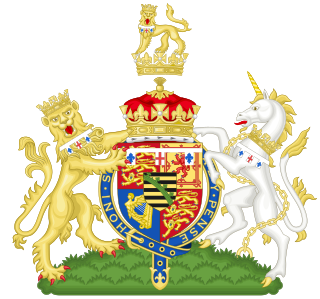
Duke of Connaught and Strathearn was a title in the Peerage of the United Kingdom that was granted on 24 May 1874 by Queen Victoria of the United Kingdom of Great Britain and Ireland to her third son, Prince Arthur. At the same time, he was also granted the subsidiary title of Earl of Sussex.

Alexander Cambridge, 1st Earl of Athlone, was a member of the extended British royal family, as a great-grandson of King George III, a brother of Queen Mary, uncle to the Kings Edward VIII and George VI, and the husband of Princess Alice of Albany. He was a British Army commander, who served as Governor-General of the Union of South Africa and Governor General of Canada.

Prince Arthur of Connaught was a British military officer and a grandson of Queen Victoria. He served as Governor-General of the Union of South Africa from 20 November 1920 to 21 January 1924.
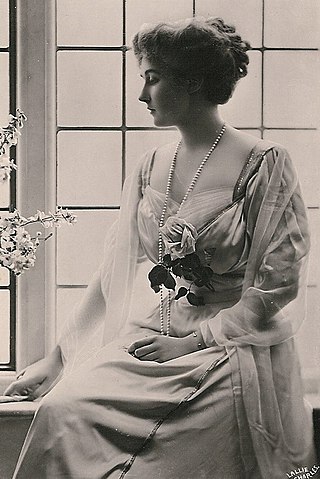
Lady Victoria Patricia Helena Elizabeth Ramsay was a granddaughter of Queen Victoria. Upon her marriage to Alexander Ramsay, she relinquished her title of a British princess and the style of Royal Highness.
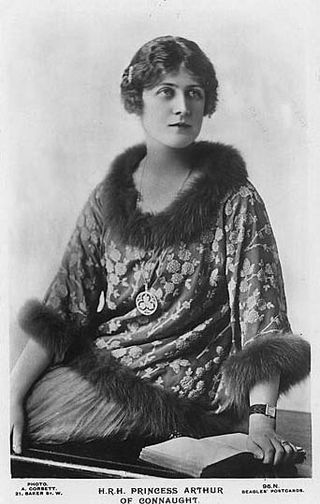
Princess Alexandra, 2nd Duchess of Fife, born Lady Alexandra Duff and known as Princess Arthur of Connaught after her marriage, was the eldest surviving grandchild of Edward VII and also the first cousin of George VI. Alexandra and her younger sister, Maud, had the distinction of being the only female-line descendants of a British sovereign officially granted both the title of Princess and the style of Highness.

Alastair Arthur Windsor, 2nd Duke of Connaught and Strathearn was a member of the British Royal Family. He was the only child of Prince Arthur of Connaught and Princess Alexandra, 2nd Duchess of Fife. He was a great-grandson of Queen Victoria through his father and a great-great-grandson of Queen Victoria through his mother. He was also a descendant of Victoria's paternal uncle and predecessor, William IV, through an illegitimate line.

Princess Louise Margaret of Prussia, later Duchess of Connaught and Strathearn, was a member of the House of Hohenzollern who married into the British royal family. She served as the viceregal consort of Canada while her husband, Prince Arthur, Duke of Connaught and Strathearn, served as the governor general, from 1911 to 1916.
Colonel-in-chief is a ceremonial position in a military regiment. It is in common use in several Commonwealth armies, where it is held by the regiment's patron, usually a member of the royal family.
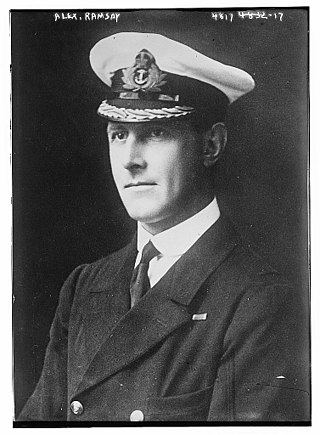
Admiral Sir Alexander Robert Maule Ramsay was a Royal Navy officer. He was the husband of Princess Patricia of Connaught, the youngest child of Prince Arthur, Duke of Connaught and Strathearn, third son of Queen Victoria. He served with distinction during the First World War. During the 1920s and 1930s, he held several important naval aviation commands.

The history of monarchy in Canada stretches from pre-colonial times through to the present day. The date monarchy was established in Canada varies; some sources say it was when the French colony of New France was founded in the name of King Francis I in 1534, while others state it was in 1497, when John Cabot made landfall in what is thought to be modern day Newfoundland or Nova Scotia, making a claim in the name of King Henry VII. Europeans in the 16th and 17th centuries often considered the territories belonging to different aboriginal groups to be kingdoms. Nevertheless, the present Canadian monarchy can trace itself back to the Anglo-Saxon period and ultimately to the kings of the Angles and the early Scottish kings; monarchs reigning over Canada have included those of France, those of the United Kingdom, and those of Canada. Canadian historian Father Jacques Monet said of Canada's Crown, "[it is] one of an approximate half-dozen that have survived through uninterrupted inheritance from beginnings that are older than our Canadian institution itself."

The Royal Burial Ground is a cemetery used by the British royal family. Consecrated on 23 October 1928 by the Bishop of Oxford, it is adjacent to the Royal Mausoleum, which was built in 1862 to house the tomb of Queen Victoria and Prince Albert. The burial ground lies on the Frogmore estate within the Home Park at Windsor, in the English county of Berkshire.

By the arrangements of the Canadian federation, the Canadian monarchy operates in Newfoundland and Labrador as the core of the province's Westminster-style parliamentary democracy. As such, the Crown within Newfoundland and Labrador's jurisdiction is referred to as the Crown in Right of Newfoundland and Labrador, His Majesty in Right of Newfoundland and Labrador, or the King in Right of Newfoundland and Labrador. The Constitution Act, 1867, however, leaves many royal duties in the province specifically assigned to the sovereign's viceroy, the lieutenant governor of Newfoundland and Labrador, whose direct participation in governance is limited by the conventional stipulations of constitutional monarchy.
The relationship between the Canadian Crown and the Canadian Armed Forces is both constitutional and ceremonial, with the king of Canada being the commander-in-chief of the Canadian Forces and he and other members of the Canadian royal family holding honorary positions in various branches and regiments, embodying the historical relationship of the Crown with its armed forces. This construct stems from Canada's system of constitutional monarchy and through its 500 years of monarchical history, the relationship symbolically represented through royal symbols, such as crowns on military badges and insignia, coats of arms, royal portraits, and the grant of the royal prefix to various military units and institutions. The role of the Canadian sovereign within the Canadian Armed Forces is established within the Canadian constitution, the National Defence Act, and the King's Regulations and Orders (KR&Os) for the Canadian Forces.
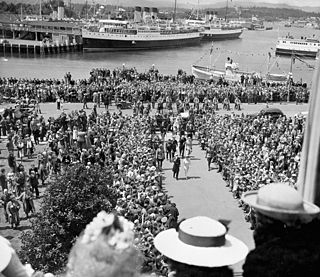
Royal tours of Canada by the Canadian royal family have been taking place since 1786—when the future King William IV became the first member of the royal family to visit Canada—and continue into the 21st century, either as an official tour, a working tour, a vacation, or a period of military service by a member of the royal family. In 1939, King George VI became the first reigning monarch to tour the country.
The 1874 Birthday Honours were appointments by Queen Victoria to various orders and honours to reward and highlight good works by citizens of the British Empire. The appointments were made to celebrate the official birthday of the Queen and were published in The London Gazette in May and June 1874.
Canadian royalty may refer to Canadians; who are members of royal families, Canadian through birth, naturalization, or marriage; or Canadian families that are given the epithet or moniker as Canadian royalty or Canadian royals. Additionally, Canada is a monarchy, so members of the Canadian monarchy are Canadian royalty.
References
- ↑ "Ireland". The Times. 8 January 1900.
- ↑ "No. 21108". The London Gazette . 26 June 1850. p. 1807.
- 1 2 3 4 5 6 Bousfield, Arthur; Toffoli, Gary (2010). Home to Canada: Royal Tours 1786–2010. Tonawanda: Dundurn Press. p. 80. ISBN 978-1-55488-800-9.
- ↑ Erickson, Carolly (15 January 2002). Her Little Majesty: The Life of Queen Victoria. New York: Simon & Schuster. ISBN 978-0-7432-3657-7.
- ↑ "No. 23391". The London Gazette . 19 June 1868. p. 3431.
- ↑ "No. 23436". The London Gazette . 30 October 1868. p. 5467.
- ↑ "No. 23522". The London Gazette . 3 August 1869. p. 4313.
- 1 2 Bousfield & Toffoli 2010 , p. 81
- ↑ Bousfield & Toffoli 2010 , p. 82
- 1 2 Bousfield & Toffoli 2010 , p. 83
- ↑ Hubbard, R.H. (1977). Rideau Hall. Montreal and London: McGill-Queen's University Press. p. 17. ISBN 978-0-7735-0310-6.
- ↑ "No. 23751". The London Gazette . 30 June 1871. p. 3006.
- ↑ "No. 24849". The London Gazette . 29 May 1880. p. 3269.
- ↑ India Office (1819). The India List and India Office List. London: Harrison. Retrieved 7 July 2013.
- 1 2 "Army Commands" (PDF). Retrieved 21 November 2015.
- ↑ "No. 26084". The London Gazette. 2 September 1890. p. 4775.
- ↑ "No. 26458". The London Gazette. 14 November 1893. p. 6356.
- ↑ "No. 26446". The London Gazette. 3 October 1893. p. 5554.
- ↑ Army List, various dates.
- ↑ "No. 27154". The London Gazette . 16 January 1900. p. 289.
- ↑ "No. 27360". The London Gazette . 1 October 1901. p. 6400.
- ↑ Athensjournals (PDF). Athens. p. - 7.
- ↑ "No. 24098". The London Gazette . 26 May 1874. p. 2779.
- ↑ "House Laws of the Saxe-Coburg and Gotha". Heraldica.org.
- ↑ King, Greg (2007). Twilight of Splendor: The Court of Queen Victoria During Her Diamond Jubilee. Hoboken: John Wiley & Sons. p. 59. ISBN 978-0-470-04439-1.
- ↑ Edmonton Bulletin, 9 March 1906
- ↑ "Court News". The Times. No. 36936. London. 27 November 1902. p. 10.
- ↑ Cox, Martin. "Union-Castle Line – A brief Company History". Maritime Matters. Archived from the original on 17 September 2008. Retrieved 28 September 2008.
- ↑ "The Anglo-Boer War Memorial at the Museum of Military History". The All at Sea Network. Archived from the original on 18 September 2008. Retrieved 28 September 2008.
- 1 2 Office of the Governor General of Canada. "Governor General > Former Governors General > Field Marshal His Royal Highness the Prince Arthur, Duke of Connaught and Strathearn". Queen's Printer for Canada. Retrieved 30 April 2009.
- 1 2 Bousfield & Toffoli 2010 , p. 85
- ↑ Bousfield & Toffoli 2010 , p. 86
- ↑ Bousfield & Toffoli 2010 , p. 87
- ↑ "History – Past Royal Connections". Cape Town Highlanders Website (Unofficial). Archived from the original on 8 October 2007. Retrieved 28 August 2008.
- ↑ Hubbard, R.H. (1977). Rideau Hall. Montreal and London: McGill-Queen's University Press. pp. 137. ISBN 978-0-7735-0310-6.
- ↑ Borden, Robert (1 January 1969). Memoires. Vol. 1. Toronto: McClelland and Stewart. pp. 601–602.
- ↑ Drive, Chapman's Peak. "History". Chapmans Peak Drive. Retrieved 1 July 2020.
- ↑ Harrison, Brian, ed. (2004), "Arthur, Prince, first duke of Connaught and Strathearn", Oxford Dictionary of National Biography, vol. I, Oxford: Oxford University Press
- ↑ Jane Shuter; Rosemary Rees; William Beinart; Edward Teversham; Rick Rogers (2015). Searching for rights and freedoms in the 20th century. London: Pearson Education Limited. p. 196. ISBN 978-1-447-98533-4.
- ↑ Bell, Edward (4 June 1939), Letter to Mrs. E.I.J. Bell, The Letter Repository, archived from the original on 6 January 2009, retrieved 25 April 2010
- ↑ "The Late Duke of Connaught". The Times. No. 49189. London. 20 March 1942. p. 7.
- ↑ "Royal Burials in the Chapel since 1805". College of St George - Windsor Castle. Retrieved 5 March 2023.
- ↑ "Duke Of Connaught Dead In England, 91. Last of Four Sons of Queen Victoria, Governor General of Canada, 1911-16. King Orders Mourning. Senior Field Marshal of the British Army Had a Notable Career in Armed Forces". New York Times . 17 January 1942. p. 8.
- ↑ Evans, Rob; Pegg, David (18 July 2022). "£187m of Windsor family wealth hidden in secret royal wills". The Guardian. Retrieved 19 July 2022.
- ↑ "British Royalty Cadency". Heraldica. Retrieved 27 April 2010.
- ↑ Louda, Jiří; Maclagan, Michael (1999). Lines of Succession: Heraldry of the Royal Families of Europe. London: Little, Brown. p. 34. ISBN 1-85605-469-1.
- ↑ "60 Richmond Street / Connaught Square". Canada's Historic Places. Parks Canada. Retrieved 20 October 2021.
External links
- Works by or about Prince Arthur, Duke of Connaught and Strathearn at Internet Archive
- "Archival material relating to Prince Arthur, Duke of Connaught and Strathearn". UK National Archives.
- Portraits of Prince Arthur, Duke of Connaught and Strathearn at the National Portrait Gallery, London
- 8 May 1915, newspaper coverage of the Duke of Connaught's appearance at McGill University Convocation. Archived 13 February 2010 at the Wayback Machine
- Scouting Round the World, John S. Wilson, first edition, Blandford Press 1959 p. 81